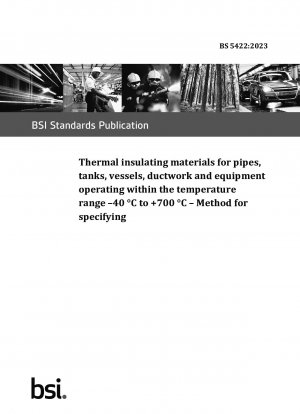BS 5422:2023
Thermal insulating materials for pipes, tanks, vessels, ductwork and equipment operating within the temperature range –40 °C to +700 °C. Method for specifying
- Standard No.
- BS 5422:2023
- Release Date
- 2022
- Published By
- British Standards Institution (BSI)
- Latest
- BS 5422:2023
- Scope
- What is BS 5422 - Thermal insulating materials for pipes about? BS 5422 sets out how to establish and specify minimum thermal insulation requirements for pipework and other equipment. BS 5422 reflects the latest energy efficiency requirements. Who is BS 5422 - Thermal insulating materials for pipes for? BS 5422 on thermal insulating materials for pipes can be adopted by specifiers and manufacturers of insulation materials including finishing materials, designers of insulation, and contractors working with thermal insulation, including: Mechanical services designers and contractors Ventilation designers and contractors Process industry designers Insulation industry contractors Pipeline installation contractors Retrofit advisors Insulation designers Heating and ventilation designers What does BS 5422 - Thermal insulating materials for pipes cover? BS 5422 on thermal insulating materials for pipes describes a method for specifying requirements for thermal insulating materials on pipes, tanks, vessels, ductwork and equipment for certain defined applications and conditions within the temperature range –40 °C to +700 °C.
BS 5422:2023 history
- 2022 BS 5422:2023 Thermal insulating materials for pipes, tanks, vessels, ductwork and equipment operating within the temperature range –40 °C to +700 °C. Method for specifying
- 2008 BS 5422:2009 Method for specifying thermal insulating materials for pipes, tanks, vessels, ductwork and equipment operating within the temperature range –40 °C to +700 °C
- 2001 BS 5422:2001 Method for specifying thermal insulating materials for pipes, tanks, vessels, ductwork and equipment operating within the temperature range -40 °C to +700 °C
